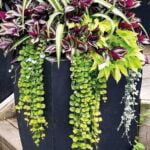Are you looking for inspiration to create a stunning oceanscape landscape? Look no further. In this article, we will explore various ideas for oceanscape landscape design that will help transform your outdoor space into a breathtaking coastal retreat. Whether you live by the sea or simply want to bring a touch of the ocean to your backyard, these creative ideas and tips will guide you through the process of planning, designing, and maintaining an oceanscape landscape.
When it comes to creating an oceanscape landscape, the possibilities are endless. From coastal plant selection to incorporating natural elements like rocks and water features, there are numerous ways to capture the beauty of the ocean in your outdoor space. Additionally, we will also discuss sustainable practices for maintaining an eco-friendly oceanscape landscape and adding seaside decor elements to enhance the overall aesthetic.
Throughout this article, we will delve into case studies of real-life examples of stunning oceanscape landscapes from around the world. These case studies will provide valuable insight and inspiration for your own oceanscape landscape design. Join us as we embark on a journey to explore the allure of oceanscape landscapes and discover how you can bring the serenity of the ocean into your own backyard.
Planning and Design
When it comes to creating a breathtaking oceanscape landscape, careful planning and thoughtful design are key. Whether you’re working with a small coastal plot or a larger beachfront property, there are several tips to keep in mind to ensure that your oceanscape landscape is both beautiful and functional.
Working With the Natural Environment
One of the most essential aspects of planning an oceanscape landscape is to work with, rather than against, the natural environment. This means taking into consideration factors such as wind patterns, salt spray, and soil composition when selecting plants and designing hardscaping features. By choosing native plant species that are well-adapted to coastal conditions, you can create a low-maintenance and sustainable landscape that thrives in its environment.
Creating Visual Interest
Incorporating visual interest into your oceanscape landscape design is crucial for capturing the essence of the ocean. Utilizing elements such as meandering pathways, driftwood sculptures, and strategically placed water features can evoke the feeling of being by the sea. Additionally, incorporating varying textures and colors in plant choices can add depth and dimension to your oceanscape landscape.
Designing for Sustainability
Implementing sustainable practices into your oceanscape landscape design not only benefits the environment but also ensures long-term success for your project. Consider incorporating permeable hardscaping materials to reduce runoff and erosion, installing a rainwater harvesting system for irrigation purposes, and utilizing drought-tolerant plants to minimize water usage. By designing with sustainability in mind, you can create an oceanscape landscape that is not only visually stunning but also ecologically responsible.
Coastal Plant Selection
When it comes to creating a stunning oceanscape landscape, selecting the right plants is crucial to ensure that they thrive in salty, coastal environments. Coastal plant selection requires careful attention to the unique conditions of the area, including salt spray, strong winds, and sandy soil. When choosing plants for your oceanscape landscape, consider native species that are well-adapted to these challenging conditions.
One popular option for coastal plant selection is sea oats (Uniola paniculata), a grass that is commonly found along coastlines. Sea oats are known for their ability to stabilize sand dunes and prevent erosion, making them an excellent choice for coastal landscapes. Additionally, salt-tolerant shrubs like beach rose (Rosa rugosa) and bayberry (Myrica pensylvanica) can add beauty and resilience to your oceanscape landscape.
In addition to selecting native coastal plants, consider incorporating ornamental grasses such as marram grass (Ammophila breviligulata) and switchgrass (Panicum virgatum) to add texture and visual interest to your oceanscape landscape. These hardy grasses are well-suited for coastal environments and can withstand the harsh conditions typically found near the ocean. By carefully selecting plants that are adapted to salty, coastal environments, you can create a breathtaking oceanscape landscape that thrives year-round.
Natural Elements
When creating an oceanscape landscape, incorporating natural elements is essential to mimic the look and feel of the ocean. Rocks, sand, and water features are key components that can bring the tranquility of the ocean into your outdoor space.
Rocks can be strategically placed to create a dynamic and visually appealing element in your oceanscape landscape. Consider using a variety of rock sizes and shapes to mimic natural coastal formations. They can also act as borders for different areas within your landscape, such as a rock-lined pathway or garden bed.
In addition to rocks, incorporating sand into your oceanscape landscape design can add texture and authenticity to the coastal theme. Sand dunes or sandy pathways can evoke a beach-like atmosphere, while also providing excellent drainage for plants that thrive in coastal environments.
Water features are another vital aspect of an oceanscape landscape. Ponds, fountains, or even small cascading streams can replicate the soothing sound and movement of ocean waves. These features not only add a sense of tranquility but also provide habitat for wildlife and contribute to the overall ecosystem.
| Component | Importance |
|---|---|
| Rocks | Create visual appeal and define landscape areas |
| Sand | Adds texture and aids in drainage for coastal plants |
| Water Features | Replicates soothing sounds and movements of ocean waves |
Sustainable Practices
When it comes to creating and maintaining an oceanscape landscape, sustainability is key. By utilizing eco-friendly practices, you can ensure that your stunning coastal oasis not only thrives but also has a positive impact on the environment. From water conservation to responsibly sourced materials, there are plenty of sustainable ideas for maintaining an oceanscape landscape.
Water Conservation
One of the most important sustainable practices when it comes to oceanscape landscaping is water conservation. With the use of drought-resistant plants and efficient irrigation systems, you can significantly reduce water consumption while still keeping your coastal oasis looking lush and vibrant. Rainwater harvesting and greywater recycling are also great options for minimizing water waste and maintaining a sustainable oceanscape landscape.
Native Planting
Choosing native plants for your oceanscape landscape not only ensures that the flora will thrive in a saline environment but also supports local ecosystems. Native planting reduces the need for excessive watering, fertilization, and pest control, ultimately contributing to a more sustainable coastal landscape. Additionally, these plants provide habitat and food sources for local wildlife, further enhancing the ecological benefits of your oceanscape landscape design.
Recycled Materials
Incorporating recycled materials into your oceanscape landscape design is another eco-friendly practice that can contribute to sustainability. From reclaimed wood for decking and fences to recycled glass for decorative elements, using recycled materials not only reduces waste but also adds character and charm to your coastal oasis. Additionally, sourcing materials locally can further minimize the environmental impact of transportation and production.
By embracing sustainable practices in creating and maintaining your oceanscape landscape, you can enjoy a beautiful coastal retreat while minimizing the environmental footprint of your outdoor space. From water conservation and native planting to utilizing recycled materials, there are plenty of eco-friendly ideas that can enhance the sustainability of your stunning oceanscape landscape design.
Seaside Decor
When it comes to creating a stunning oceanscape landscape, incorporating seaside decor is crucial to achieving an authentic and captivating look. From driftwood and nautical elements to beach-inspired accents, these features will help bring the beauty of the ocean straight to your outdoor space.
One of the key elements in seaside decor is driftwood, which can be used in a variety of ways to enhance the natural aesthetic of your oceanscape landscape. Consider using driftwood as part of a unique focal point, such as a sculpture or art installation that captures the essence of coastal living.
In addition to driftwood, nautical decor items such as ropes, pulleys, and vintage buoys can add a touch of maritime charm to your oceanscape landscape. By strategically placing these elements throughout your outdoor space, you can evoke the feeling of being near the ocean even if you’re miles away from the coast.
Another way to infuse seaside decor into your oceanscape landscape is by incorporating beach-inspired accents like seashells, starfish, and rope-wrapped accessories. These small but impactful details can make a big difference in bringing the beauty and tranquility of the ocean into your own backyard.
For those looking to take their oceanscape landscape to the next level, consider adding larger statement pieces like weathered anchors or even salvaged boat parts for an authentic touch. Whether through large installations or small decorative touches, seaside decor is essential for capturing the essence of coastal living within your outdoor space.
| Seaside Decor Ideas | Description |
|---|---|
| Driftwood Sculptures | Use driftwood to create unique focal points in the landscape |
| Nautical Decor | Incorporate ropes, pulleys, and buoys for maritime charm |
| Beach-Inspired Accents | Add seashells, starfish, and rope-wrapped accessories for a coastal touch |
Maintenance
Maintaining an oceanscape landscape requires a combination of regular upkeep and thoughtful care to ensure that it continues to look pristine year-round. By implementing the right maintenance strategies, you can preserve the beauty of your coastal oasis and keep it flourishing for years to come.
Here are some essential tips for maintaining your oceanscape landscape:
- Regular watering: Coastal environments can be harsh on plants due to salty air and soil, so it’s important to provide regular watering to keep them hydrated and healthy. Consider installing a drip irrigation system to ensure consistent moisture levels for your plants.
- Pruning and trimming: Keep an eye on the growth of your coastal plants and trim them as needed to maintain their shape and promote new growth. Remove any dead or damaged branches to prevent disease and maintain the overall aesthetics of your oceanscape landscape.
- Soil care: Monitor the quality of the soil in your oceanscape landscape and make adjustments as needed. Add organic matter such as compost to improve soil structure, fertility, and water retention.
- Seasonal cleanup: Take the time to remove debris such as seaweed, driftwood, and other natural elements that may wash up onto your oceanscape landscape. This will help maintain its pristine appearance while also preventing potential damage to your plants.
By following these maintenance tips, you can ensure that your oceanscape landscape remains a stunning coastal retreat throughout every season.
Remember, proper maintenance is crucial for preserving the beauty of your oceanscape landscape while also ensuring its long-term health and vitality. With these maintenance practices in place, you can continue to enjoy the allure of coastal living in your own backyard.
Case Studies
When it comes to oceanscape landscapes, drawing inspiration from real-life examples can provide valuable insight and ideas for creating your own stunning coastal oasis. Here are some case studies of breathtaking oceanscape landscape designs from around the world:
1. The Great Barrier Reef Gardens in Australia: This iconic natural wonder has served as inspiration for many oceanscape landscapes. Incorporating a diverse array of coral-like plants, colorful blooms, and water features, these gardens mimic the vibrant beauty of the coral reef.
2. The Coastal Dunes of Cape Cod, Massachusetts: The undulating dunes and windswept landscapes of Cape Cod have inspired many oceanscape designs. Utilizing native beach grasses, rugged rock formations, and driftwood accents, these landscapes capture the wild and untamed beauty of the coast.
3. The Zen Gardens of Japan’s Coastal Regions: Japanese gardens have long been admired for their serene and tranquil beauty. Oceanscape landscapes in Japan often feature carefully raked sand or gravel to mimic the ebb and flow of ocean waves, along with minimalist plantings and natural stone elements.
By studying these real-life examples of oceanscape landscapes, you can gain valuable insights into how to incorporate natural elements, sustainable practices, and coastal decor into your own design. Whether you’re aiming for a tropical paradise or a rugged coastal retreat, drawing inspiration from these stunning landscapes can help you create a truly unique oceanscape landscape design.
Conclusion
In conclusion, oceanscape landscape ideas offer a unique and captivating way to bring the beauty of the ocean into your outdoor space. By incorporating natural elements like rocks, sand, water features, and coastal plants, you can create a breathtaking and sustainable seascape that will thrive in salty, coastal environments. Additionally, the inclusion of seaside decor such as driftwood and nautical accents adds a charming touch to these landscapes.
One of the key benefits of oceanscape landscapes is their ability to evoke a sense of tranquility and relaxation. The sound of water features coupled with the sight of coastal plants swaying in the breeze creates a peaceful atmosphere perfect for unwinding after a long day. Not only do oceanscape landscapes provide a beautiful backdrop for outdoor living spaces, but they also support local ecosystems by providing habitat for wildlife and promoting biodiversity.
As we’ve seen from the case studies presented, there are numerous real-life examples of stunning oceanscape landscape designs around the world that showcase the versatility and adaptability of this concept. From sandy coastal retreats to rocky shorelines, each design highlights the unique beauty of oceanscapes and serves as inspiration for those looking to embark on their own landscaping project.
Whether you live by the coast or simply want to bring a little piece of the ocean into your backyard, oceanscape landscape ideas offer endless possibilities for creating an outdoor oasis that celebrates nature’s most mesmerizing elements.
Frequently Asked Questions
How Can I Make My Landscape Painting More Interesting?
To make your landscape painting more interesting, you can experiment with different perspectives and compositions. Consider using a variety of textures and colors to add depth to the scene.
You can also incorporate elements like wildlife or human figures to create a sense of narrative or activity within the landscape. Playing with light and shadow can also bring a new dimension to your painting, adding drama and interest.
What Are the Different Types of Scapes in Art?
In art, there are several different types of “scapes” that artists often depict. These include landscapes (which depict natural scenery such as mountains, valleys, forests, etc.
), seascapes (which focus on the sea or ocean), cityscapes (showcasing urban environments), and skyscapes (highlighting the sky and atmosphere). Each type of scape offers its own unique set of challenges and opportunities for artistic expression.
What Is the Difference Between Landscape and Seascape?
The main difference between landscape and seascape lies in the subject matter depicted. Landscape paintings typically showcase scenes of natural scenery such as forests, rivers, mountains, or valleys.
On the other hand, seascape paintings specifically focus on depicting the sea or ocean, often including elements like beaches, cliffs, ships, and marine life. While both landscape and seascape share similarities in terms of capturing natural beauty, they each have their own distinct features that make them unique within the realm of art.

Welcome to my gardening blog! I am passionate about plants and enjoy sharing my knowledge and experiences with others. In this blog, I will write about everything related to gardening, from tips on how to get started to updates on my own garden projects.





